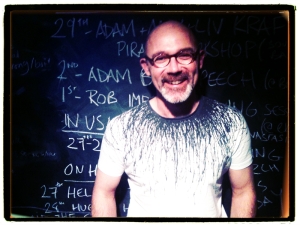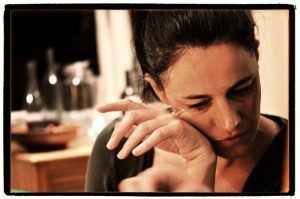 For Rob Poynton, improvisation is not just the preserve of actors and musicians, but rather something we all do everyday. According to Rob, “only the dead don’t improvise”. Learning to improvise better, can help us learn to live better. If I sound slightly evangelical, that’s because I am (who’d have thought playing Slow-mo Samurai could be so, erm, edifying). Rob shares his insight all over the place, from Oxford University’s Said Business School, to London-based brand gurus Eatbigfish, to the remote Spanish hilltop he calls home. He’s written a book too… Don’t cue the lights, or camera, or action. In fact don’t cue anything… Ladeez & gents, it’s Rob Poynton.
For Rob Poynton, improvisation is not just the preserve of actors and musicians, but rather something we all do everyday. According to Rob, “only the dead don’t improvise”. Learning to improvise better, can help us learn to live better. If I sound slightly evangelical, that’s because I am (who’d have thought playing Slow-mo Samurai could be so, erm, edifying). Rob shares his insight all over the place, from Oxford University’s Said Business School, to London-based brand gurus Eatbigfish, to the remote Spanish hilltop he calls home. He’s written a book too… Don’t cue the lights, or camera, or action. In fact don’t cue anything… Ladeez & gents, it’s Rob Poynton.
THE LESSON: This came thanks to a complete stranger I met by chance at the Jazz festival in Copenhagen. He was in software and when I mentioned I worked with improvisation he started talking to me about Agile Project Management and SCRUM – two forms of highly flexible working that are used in the software industry (which I had never heard of). This got me very excited and sparked off a whole chain of associations and inquiry. What I learned was that there many stories of improvisational ways of working (the ones that I am interesting in spreading) already out there, we just tend not to see them. I have since found plenty of other examples. My idea is to collect and compile improvisational ‘case stories’, in order to re-frame how we think about what it takes to be successful in the messy world of everyday reality, not the idealised world of business school post rationalisation.
THE QUESTION: For me, this is the year of hosting. The question I am fascinated by is what it takes to design a rich, learning experience. This means asking other questions, like – How much do you need to structure and organise? How much do you leave open? What kind of stimulus do you need? Of what kind? And so on.
I am engaged with several experiments in this area.
- The Creative Tapas Experiment here in Spain, which is an exploration of the conditions needed for co-creativity with a group of about fifty people.
- My work with Marshall Young on the design of the Oxford Praxis Forum, another ‘container’ designed to explore how senior leadership practioners can interact with a research University for mutual benefit.
- Using the space I have in Arenas to host personalised retreats for individuals, called ‘Parenthesis’. The idea is to give people time-out to think and reflect deeply on intractable dilemmas, in surroundings that allow them to reconnect with themselves and with nature.
THE INSPIRATION: The Leonardo at the Court of Milan exhibition at the National Gallery. It had everything stacked against it because it was so difficult to get in and so crowded once you did (rather like looking at art on a rush hour tube). Once I got over that, I found it truly inspirational.
For me it was the sketches and drawings combined with the explanations on the audio guide of how Leonardo worked that I found inspirational. He was incredibly collaborative, would allow ideas to emerge and evolve enormously during the process, and was happy to leave things ‘unfinished’. Here was somebody at the very highest level of creative endeavour, yet he worked in a way that was very adaptive and improvisational.
